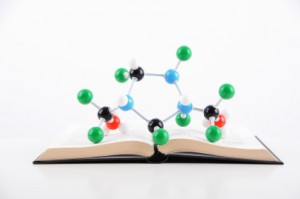One day while reading a knitting blog I discovered in 1883 a Scottish chemist created the first “ball-and-stick” model of a molecule using knitting needles and balls of yarn. This initial ball-and-stick molecule represents the structure of sodium chloride and is constructed of knitting needles, representing the bonds, and alternating balls of blue and red yarn, representing the atoms of sodium and chloride. It was displayed as part of the International Year of Chemistry 2011 activities.
The chemist who created this model was Alexander Crum Brown, distinguished chemistry and professor at the University of Edinburgh, and one of his particular interests was the arrangements of atoms in molecules and the depiction of these structures. Those of us who spent countless hours poring our organic chemistry books and molecular model sets trying to understand nucleophilic attacks and SN1 and SN2 reactions have Alexander Crum Brown to thank. Those students who now use computer 3D modeling programs to accomplish the same studies (without the delight of chasing down the last nitrogen atom that has rolled off the desk and under the dresser) are also indebted to Dr. Brown.
Continue reading “Knitting Needles, Balls of Yarn and the First Molecular Model”
